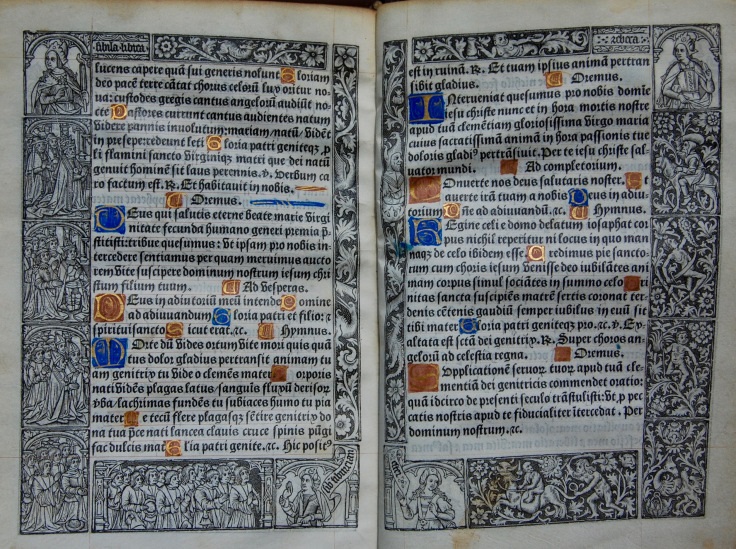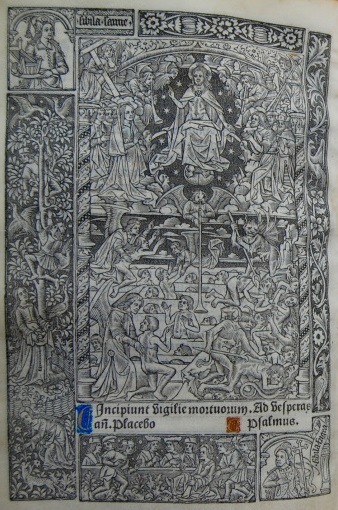This just in: Special Collections acquires a Book of Hours published in 1500
As we head toward the holidays we're reminded again at just how exciting it is to open packages: slicing through tape, unwrapping paper, shaking and guessing contents, before finally revealing the treasures tightly nestled in each box. This is especially true in Special Collections, where the boxes we unpack might reveal the latest publication by a noted book artist, or a centuries-old survivor from a bygone age. Such was the case last week, as we found ourselves unpacking a book of hours published in Paris in the year 1500. Books of hours are Christian devotional books that were popular in Europe from the middle ages and into the early modern period. They are the most common type of medieval illuminated manuscript to survive to the present, and examples such as the Les très riches heures du duc de Berry are among the most lavish books ever produced. Special Collections holds high quality facsimiles of many such works, including Les très riches heures, the misleadingly named The Hours of Henry VIII (another recent acquisition), and Les heures noires, previously discussed here. More significantly, one of our most treasured holdings is an original manuscript book of hours dating from the mid-fifteenth century, which was donated by John S. McIlhenny in 1991 to mark the library's two millionth volume.

Our newest acquisition is unusual in that it is a printed book of hours, one produced to meet the demands of an increasingly literate population by exploiting the printing press's ability to outstrip the painstakingly created manuscript books. Its printer's description is Ces presentes heures a lusaige de Rome ont este faictes pour Simon Vostre Libraire domourant a Paris a la rue neuue nostre dame a le enseigne sainct Jehan l’evangeliste, and like all such works it is organized around a series of prayers called the Hours of the Virgin, meant to be observed by laypeople at regular intervals throughout the day. This example includes text in both French and Latin as well as a religious calendar designed around a Roman model. The printer and woodcutter Philippe Pigouchet produced roughly ninety such books of hours over his thirty-year career, many with publisher Simon Vostre, in editions aimed at markets in Paris, Cambrai, and Besancon in France, and Sarum (Salisbury) in England, to name just a few. This example dates from approximately 1500, roughly the midpoint of Vostre and Pigouchet's partnership, and at the very end of the incunable period when printing in Europe was moving into its early modern maturity.

Though printed books of hours did aim to attract a wider audience than their manuscript counterparts, this is not to say that they weren't lavish creations in their own right. Vostre and Pigouchet worked to make their printed books rivals to luxurious manuscript editions by reproducing the work of some of the most famous book illuminators of the day in their publications' borders, initials, and miniatures. Some examples were hand-colored to complete the transformation into hybrid collaborations between artists and the printing press, while others, such as ours, lack such colored illustrations but do include red, blue, and gold initials added by hand. Every page is bordered with a series of intricate illustrations mixing religious scenes with depictions of everyday life, as well as twenty-two full-page illustrations. Each one is worthy of close study.

Most interesting with regard to this particular specimen is that it is printed on vellum (or parchment), not paper, further blurring the lines between manuscript and printed books. Vellum, made from animal skins, was the preferred material for manuscript books during the middle ages, but as book production increased in the age of the printing press paper quickly supplanted vellum everywhere save for official documents and books of the highest quality. That Vostre and Pigouchet chose the expensive material of vellum shows both that they intended this work as one of luxury and that they believed the market demand was strong enough to support such a large capital outlay. Our example is incomplete, lacking eight leaves -- a not-unusual state for such heavily used and yet still treasured books -- but its later eighteenth-century chagrin binding is intact and in good shape. Perhaps most amazingly only five copies of this edition are thought to survive, of which ours is the only such example publicly held in the United States. We still need to do some work cataloguing and conserving this book, but once it finds its forever-home in our stacks the tome will be available for consultation in our reading room by students, faculty, and the general public alike. Come by and take a look: while we can't promise to replicate the joy of seeing this book emerge from its shipping container, we feel certain that its detailed illustrations, hand-colored initials, and fine parchment won't disappoint!
